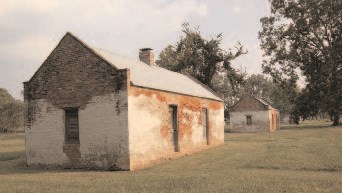Last updated: September 29, 2022
Article
Durability of Traditional and Modifed Limewashes

Authors
- SARAH MARIE JACKSON
- TYE BOTTING
- MARY STRIEGEL
Increased knowledge of recipes and additives could improve the performance of limewash applied to historic materials.
Introduction
The National Center for Preservation Technology and Training (NCPTT) recently completed a study of the durability of traditional and modifed limewash formulations. The study tested a variety of limewash recipes for possible use on historic structures located in the Cane River Creole National Historical Park, located in central Louisiana.
Limewashes have long been used as surface fnishes on buildings and other structures, on both the interior and the exterior. As limewash slowly dries, it reacts with the carbon dioxide in the air, carbonating and creating a tough fnish. During the height of limewash’s popularity, prior to the industrial age, the knowledge and skills needed for effective application were passed on from craftsman to craftsman. The basic ingredients, lime and water, were readily available in every community. Additives used were commonly available and often varied from place to place.
As the popularity of limewash waned in the U.S. and modern paints began to be used widely, experience with limewash recipes and their application began to fade. Today, instead of every community having someone knowledgeable in limewash, experienced craftsmen are spread thinly across the country. The waning popularity of limewash did not result solely from the rise in popularity of modern paints; other factors were the increased cost of labor and creation of more durable, inexpensive materials materials that did not need a fnish for protection.
